Introduction to Construction Site Safety and Efficiency
Construction sites can be hazardous environments. Working at heights, heavy machinery, hazardous materials, and exposure to extreme weather all contribute to increased risks for workers. At the same time, construction projects operate on tight deadlines and budgets. Delays due to unsafe working conditions or weather can have major impacts on the bottom line.
That’s why optimizing both safety and efficiency is crucial to any construction project. There are many factors that influence these goals, but one that is often overlooked is the role of heaters. Heaters may seem like a luxury, but they can have profound impacts on safety, productivity, materials, worker comfort, and more.
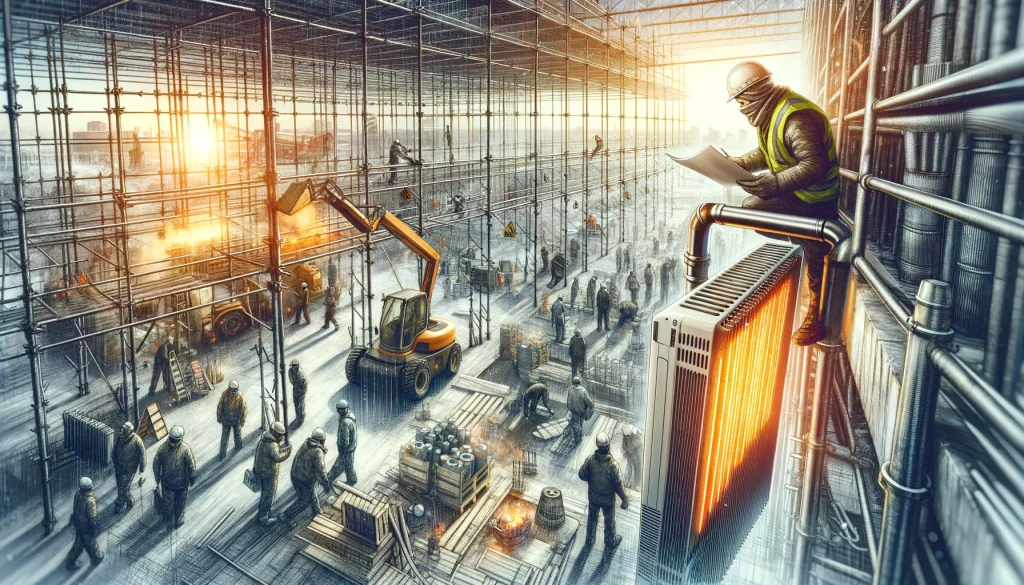
In this comprehensive guide, we’ll take an in-depth look at how heaters can maximize safety and efficiency specifically on scaffolding projects. Proper integration of heating systems in scaffolding during construction is complex but pays dividends when done effectively. We’ll cover everything from heater types, placement strategies, cost-benefit analysis, regulations, and real-world case studies.
Let’s get started understanding how this vital but often neglected construction tool when thoughtfully implemented, can optimize project success.
Overview of Scaffolding in Construction Projects
Scaffolding is a temporary structure that provides elevated working platforms to access heights not otherwise reachable. On construction sites, scaffolding allows workers to conduct tasks like:
- Brickwork and masonry
- Painting
- Plastering
- Rigging
- Roofing
Scaffolding provides a safer alternative to ladders for working at height. Systems like tube and clamp or system scaffolds are modular, allowing versatile configurations. Suspended scaffolds hang from roofs for exterior work. Shoring scaffolds support formwork or unfinished walls.
Scaffolding may be assembled on-site or prefabricated for rapid installation. Large, complex projects use multiple scaffolding structures tailored to each task. Strict protocols exist for scaffold erection, inspection, and dismantling.
With workers often exposed to outdoor conditions on scaffolding, heating systems are frequently necessary. But safety should be the first priority. We’ll explore considerations like:
- Structural integrity with added load
- Fire hazards
- Power supply
- Placement and heat distribution
Proper heater integration in scaffolding projects requires planning and foresight. But the boost to safety, productivity, and quality makes the effort worthwhile.
Heaters in Construction: An Essential Tool
Heat impacts almost every aspect of a construction project. It affects:
- Worker performance – Dexterity, morale, health
- Materials – Curing, drying times, strength
- Machinery – Efficiency, fluids, battery life
- Scheduling – Productivity, delays from weather
Without adequate heating, cold conditions impair all of these factors. Yet most sites rely solely on ambient heat or temporary spot heaters.
A thoughtfully planned heating strategy should be part of any scaffolding project, treating heat as the essential tool it is. Options like radiant heaters, forced air units, or hydronic systems can be temporarily integrated into scaffolding structures.
The many benefits of an effective construction site heating solution include:
- Increased safety – Warm workers are alert and coordinated
- Faster construction – Materials cure and dry faster
- Higher quality – Materials strengthened, fewer flaws
- Weather resistance – Minimize delays from cold temps
- Worker retention – Improved comfort and morale
For relatively little investment, heaters often pay back their costs many times over in time and safety savings.
The Impact of Temperature on Construction Materials
Before exploring heater options, it’s important to understand how temperature impacts common construction materials.
Concrete curing and strength development basically stops below 50°F. Hydration slows, weakening the concrete and increasing curing time. Even at 70°F, full curing takes 28 days. Heaters accelerate this process.
Mortar exhibits similar curing delays when cold. This can destabilize masonry projects. Mortar joints may also freeze before setting, damaging final structures.
Steel loses impact strength below 40°F. Brittleness leads to fractures or cracks during construction. Heat treating steel post-fabrication requires precise temperatures.
Wood can shrink, swell, or split in cold weather as moisture evaporates. Sealants and adhesives also cure poorly in the cold. Nails are more likely to loosen.
With drywall, joint compounds harden slower in cold conditions. Low temperatures inhibit water evaporation. Slow curing leads to flaws.
Paint will not adhere well to cold surfaces. It becomes thick and hard to apply, reducing quality. Certain coatings like epoxies or urethanes may not cure at all in cold temps without heat.
Clearly, keeping materials warm is imperative for proper construction and finishing. Next, we’ll survey heating options that integrate safely into scaffolding.
Types of Heaters Used in Scaffolding Projects
There are several types of heaters suitable for warming scaffolding structures:
- Electric radiant – Direct infrared heating; versatile positioning
- Fuel-fired radiant – Efficient for large outdoor areas
- Forced air – Focus warming on work areas
- Hydronic – Like forced air; hoses not ducts
- Calefaction – Central heat source with fans/ducting
Electric radiant heaters offer mobility to direct heat where needed. Locate them near workers and away from materials at risk of drying too rapidly. Downsides are no residual warmth and potential shock hazard.
LP gas radiant heaters output warmth in a wide pattern, good for general area heating. Use them only in well-ventilated locations due to exhaust. Refuel frequently.
Forced air and hydronic heaters focus hot air on work zones through ducts or hoses. Hydronic uses hot water instead of a blower. Both require planning duct routes.
Calefaction involves a central heating unit linked to scaffolding via ducts and fans. This approach evenly heats whole platforms but requires installation labor.
Ideally, use a combination of radiant and forced/hydronic heaters to balance comfort and drying. Now let’s focus on safety protocols.
Safety Protocols for Heater Use on Construction Sites
While heaters improve construction efficiency and safety in cold weather, improper heater usage also introduces risks:
- Fire – Fuel-based and electrical heaters can ignite materials
- Burns – Infrared heaters emit high temperatures
- Fumes – Gas or diesel heaters produce emissions
- Electrocution – Faulty wiring can energize scaffolding
- Collapse – Added weight can compromise scaffold stability
To minimize risks, follow these safety protocols:
- Position heaters safely away from flammable materials
- Secure electrical connections; inspect routinely
- Ventilate exhaust fumes outside work areas
- Consider wireless heaters to avoid tripping hazards
- Calculate heater weight into scaffold load limits
- Train workers on proper clearance distances
- Refuel fuel-fired heaters off-site/away from ignition sources
- Use tip-over protection and mounting poles for portable heaters
- Keep multiple ABC fire extinguishers nearby
With training, signage, and monitoring, construction crews can manage heater-related risks successfully. Next, we’ll look at optimizing worker comfort.
Enhancing Worker Comfort with Appropriate Heating
Beyond keeping materials and equipment functioning well, adequate heating also enhances worker comfort, promoting safety through improved morale and productivity.
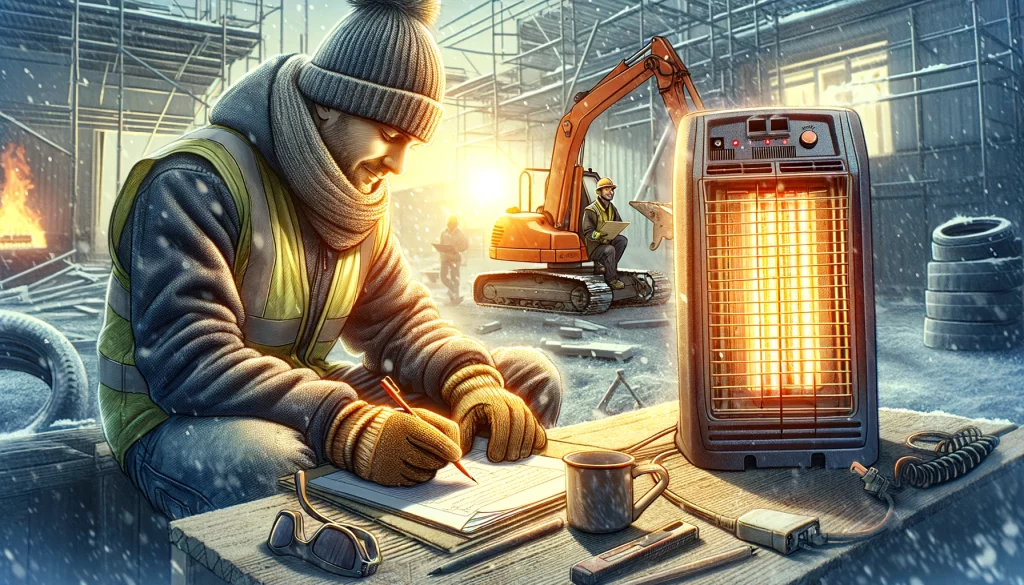
The human body is complex, but some general guidelines apply when selecting construction site heaters:
- Direct radiant heating on workers to quickly elevate core temperature
- Forced air heating maintains warmth and comfort over time
- Target a workspace temperature of 60-70°F for optimal comfort and dexterity
- Allow opportunities to control heat levels at a work zone
- Prevent abrupt temperature fluctuations that cause discomfort
- Consider infrared heating to directly replenish lost body heat
Workers will remain more alert and capable when kept comfortably warm by heaters. Personal protective clothing adds insulation against the cold.
Providing heat also sends a positive message to crews that their wellbeing is a priority. This contributes to morale and productivity on site.
Regulatory Compliance for Heating on Construction Sites
Safely integrating temporary heating on construction sites requires attention to codes and regulations such as:
- OSHA standards on heating equipment, fuel storage/handling, ventilation, etc.
- Fire codes regarding clearance, operations, emergency response
- American National Standards Institute (ANSI) heater design specifications
- Resource Conservation and Recovery Act (RCRA) for fuel storage tanks
- Permitting related to fuel tanks, generators, temporary power
Carefully select and size heaters to avoid exceeding OSHA carbon monoxide limits or blocked egress routes. Consult the certified site safety officer.
Obtain permits for any fuel tanks and temporary power supplies. Arrange appropriate fire watch and extinguishers.
Review heater specifications to ensure ANSI compliance. Seek types rated for construction site use.
Store and handle fuel properly, avoiding spills. Comply with hazardous waste (RCRA) tank rules.
Regulations serve the vital purpose of risk mitigation. Proactively consulting codes will ensure safe heating operations.
Energy Efficiency Considerations for Heaters
While safety and productivity are top concerns, energy efficiency should also factor into construction heater selection and placement.
Ways to promote efficiency:
- Size heaters appropriately – Avoid oversizing capacity
- Use tighter-focusing radiant heaters to minimize wasted heat
- Place heaters strategically to directly warm work zones
- Insulate hoses or ducts to minimize heat loss in the distribution
- Lower ambient heat during unoccupied hours but prevent freezing
- Perform routine maintenance – Clean intake/exhaust, replace filters
- Select newer heater models with improved efficiency ratings
- Weatherize temporary enclosures or tented areas heated
With planning, crews can have both comfortable, functional heating as well as responsible energy usage. Cost savings from an efficient heating system further justify the initial investment.
Case Study: Successful Heater Integration in Scaffolding
Let’s examine a real-world example where thoughtful heater integration in scaffolding brought significant benefits.
The Project
A new 5-story mixed-use structure in Boston, requiring extensive exterior scaffolding. Harsh New England winter weather was forecast.
The Challenge
Keeping masonry mortar, finishes, equipment, and workers protected from freezing conditions during critical facade construction.
The Solution
A multi-pronged heating strategy:
- Electric infrared heaters are stationed near each work zone for targeted warmth
- Hydronic hoses looping scaffolding to maintain above-freezing platform temps
- Enclosed stair towers with portable forced air heaters
- Weather barriers around perimeter scaffolding with calefaction ducted in
The Outcome
The comprehensive heating system maintained ideal construction conditions despite winter temps dipping below freezing daily. The general contractor reported:
- No weather delays – The project proceeded on schedule
- Exceptional mortar quality – No freeze damage or rework
- Improved worker productivity – Warm hands and morale
- Minimal added costs – Heating paid back through speed and quality
This case study demonstrates the substantial benefits possible from a thoughtful heating strategy.
Risk Assessment for Heater Use in Construction
Any equipment introduces risks that must be managed. With heaters, key hazards include:
Fire – Fuel-based and electric heaters can ignite materials if operated unsafely. Scaffolding structures heighten this hazard.
Health – Exhaust fumes contain carbon monoxide and other toxins at dangerous levels in confined spaces.
Equipment damage – High radiant heat outputs can damage electronics or finishes if not controlled.
Collapse – Heaters add load to scaffolding that could compromise structural integrity if not calculated properly.
Power source issues – Faulty temporary wiring presents electrocution and fire risks. Fuel spills create environmental/health dangers.
Performing a detailed risk assessment identifies potential dangers so preventive action can be taken, such as:
- Fire watch assignments
- Atmospheric monitoring
- Restricted areas
- Added ventilation
- Load testing
- Wiring inspections
- Protective barriers
Careful risk analysis, coupled with adequate hazard controls and training, enables the substantial benefits of worksite heating to be realized safely.
Installation Best Practices for Scaffolding Heaters
Once appropriate scaffolding heaters are selected, proper installation is crucial to effectiveness and safety. Follow these best practices:
- Consult engineering guidance for structural integrity and load capacity
- Securely mount radiant heaters on poles at safe distances from combustibles
- Use non-combustible reflectors to focus heat on work areas
- Affix warning signs for high temperatures on infrared heaters
- Route ductwork or hoses securely without sharp bends or blockages
- Seal duct/hose connections to prevent dangerous exhaust leaks
- Inspect all wiring and connections to confirm proper current ratings
- Install fuel lines securely avoiding trip hazards
- Allow safe clearances from heaters to scaffolding components per codes
- Position heaters for optimal heat distribution across platforms
- Test carbon monoxide sensors and flammable gas alarms
- Confirm adequate local ventilation for fuel-fired heaters
- Use sandbags or tie-downs if mounting heaters directly to scaffold tubes
- Train workers on clearance distances and emergency shutdown procedures
With professional installation and sign-off, scaffolding heaters will provide optimal performance safely.
Maintenance and Inspection of Construction Site Heaters
Heaters enable excellent productivity in cold weather, but only if maintained properly. Follow the manufacturer’s maintenance instructions for items like:
- Fuel heaters – Inspect lines/tanks for leaks. Change filters. Confirm exhaust flow.
- Electric heaters – Check wiring condition. Clean air intakes. Replace damaged cords.
- Duct/hose-fed heaters – Verify unobstructed airflow. Check for leaks/disconnects.
- Infrared heaters – Clean reflectors. Confirm functioning emitters and controls.
Establish a routine inspection schedule for all heaters covering:
- Structural mounting integrity
- Proper clearance distances
- Operational performance
- Status indicators and alarms
- Damage
- Fuel/power issues
Log all inspection results, repairs, refueling, etc. Tag any damaged units for repair or replacement.
With vigilance, construction site heaters will continue performing optimally and safely all season long.
Weather Conditions and Heater Selection
Outdoor weather conditions help determine appropriate construction site heating solutions:
- Mild cold – Portable electric heaters may suffice
- Moderate cold – Fuel-fired radiant or forced air units added
- Extreme cold – Hydronic or calefaction systems for whole-area heating
- High winds – Tie-downs, windbreaks, and ducting protection needed
- Rain/snow – Weather barriers, moisture-sealed heaters
- Sunny conditions – Use sun to advantage heating work zones
Ideally, plan movable or modular systems allowing reconfiguration as conditions change.
Monitor the weather forecast daily and adjust heating equipment accordingly. This may mean:
- Redirecting or adding radiant heaters
- Moving enclosures or windbreaks
- Boosting circulation with fans
- Covering or protecting equipment
- Planning work delays or shifts
Proper preparation makes weather less of an obstacle. Heat where needed to maintain safety and productivity.
Cost-Benefit Analysis of Heaters in Construction
While certainly an investment, the benefits of heaters on job sites typically outweigh the costs:
Costs
- Equipment purchase/rental
- Fuel or electricity
- Increased supervision and safety controls
- Added scaffold structural requirements
- Permitting and inspection fees
Benefits
- Prevent weather delays – hundreds to thousands per day
- Accelerate curing and drying – days or weeks saved
- Improve material strength and durability
- Reduce flaws and rework
- Improve worker productivity and morale
- Provide advantage over competitors
- Attract better workforce
Avoiding just one day of delay covers the cost of months of heating. And better quality leads to client satisfaction.
Run the numbers for each project, but in most cases, heaters offer an impressive return on investment that benefits the bottom line.
Training Workers for Safe Heater Operation
Any new activity on a construction site warrants proper training to control risks. This definitely applies to heater usage. Training should cover:
- Safe operation procedures – Startup, shutdown, refueling, wiring
- Inspection and maintenance – Filter cleaning, leak checks, reflector adjustment
- Placement and positioning – Proper clearances, ventilation, mounting
- Hazard awareness – High temperatures, skin burns, fire, exhaust
- Weather preparedness – Wind, rain, freezing precautions
- Emergency response – Fire, power failure, heater damage, leaks
Hands-on demos are ideal to reinforce concepts and build skills. Allow trainees to start up and adjust heaters under supervision.
Document all training and keep records onsite. Require sign-off on safety procedures. Confirm comprehension with written or oral testing.
Proper workforce training ensures everyone understands the critical safety protocols and skills for responsible heater usage.
Innovations in Heating Technology for Construction Sites
Heating technology continues advancing, giving construction sites new options:
- Microwave and electromagnetic heating – Focused heat energy dries materials faster
- Infrared curing – Precise wavelength tuning penetrates and hardens adhesives
- Transparent coatings – Let sunlight in but trap heat, reducing escape
- Carbon nanotube films – Thin material applies heating via electricity
- Exothermic reactions – Chemical processes generate heat; reusable
- Phase change materials – Store and release heat during state changes
Wireless control systems add convenience and automation for heaters and HVAC.
Improved efficiency standards make new heaters more affordable to operate. Sealed combustion improves safety.
Hybrid models allow flexible electric or fuel-fired operation. Battery units offer portability.
IoT monitoring enables remote adjustment and tracking of heaters. Analytics diagnose efficiency losses.
Embracing new solutions expands options for the right heating approach per unique project needs.
Environmental Impact of Heating on Construction Sites
Along with productivity and safety, limiting environmental impacts should factor into construction site heating strategies.
Key considerations:
- Fuel heaters – Reduce on-site emissions by using “clean” biofuels or electrification
- Efficiency – Right-size systems and maintain them properly to minimize energy waste
- Weather barriers – Reduce heat loss from wind or cold infiltration
- Zone heating – Heat only where needed vs. entire scaffolding
- Exhaust management – Safely disperse and dilute engine exhaust
- Noise control – Sound insulation around generators and blowers
- Fuel storage/handling – Prevent spills; safely contain
Mitigate ground disturbances from ducting or wiring runs. Dispose of filters and waste properly.
With forethought, temporary heating can comply with green construction principles and LEED standards.
Heater Placement Strategies for Optimal Efficiency
Heater location critically affects the efficient distribution of warmth to needed areas. Consider:
- Place fuel-fired units upwind to carry heat naturally to work zones
- Angle radiant heaters to direct infrared onto scaffolds
- Elevate heaters to facilitate air circulation underneath
- Use reflective barriers to focus radiant heat inward
- Mount heaters on outrigger support off scaffolding to maximize coverage underneath
- Arrange ducted air supplies near floor levels to take advantage of rising heat
- Position heaters near openings in enclosures to quickly replace escaping warmth
- Provide multiple access points for ducting to distribute heat to all platform levels
- Install thermostats to monitor temperature and control heater output
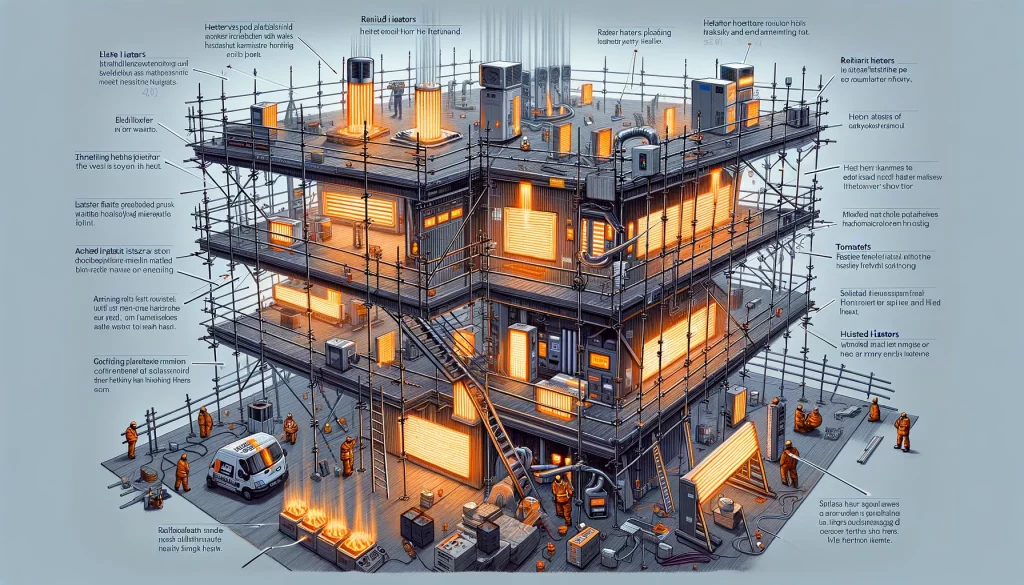
Careful placement based on heat type maximizes heating efficiency. Strategically target warmth where workers are active.
Challenges in Implementing Heaters on Scaffolding
Adding heating introduces several challenges:
- Structural loading – Heaters and fuel add considerable weight
- Power access – Getting adequate electrical supply to height safely
- Hangings and brackets – Installing these reliably to support heaters
- Scaffold access – Moving heaters and fuel to elevated platforms
- Layout limitations – Limited space for heater footprints and clearance
- Equipment protection – Shielding heaters/fuel from weather and work impacts
- Ventilation – Adequately dissipating exhaust fumes
- Permits – Additional approval processes for fuel tanks, wiring
Thorough planning minimizes issues. Perform structural analysis with weight margins. Prefab power connectivity and mounts. Use lifting equipment wisely. Seek protected layouts. Weatherproof equipment. Allow ample venting. Start permit processes early.
With foresight, even complex scaffold heating is feasible.
Emergency Protocols for Heater-Related Incidents
Emergency plans for construction sites must also address heater-related incident response, including:
Fire
- Shut off fuel and power to heaters
- Use ABC extinguishers; focus on the source but prevent the spread
- Evacuate scaffolding if fire grows
- Contact fire department
Heater damage or malfunction
- Shut off/disconnect the damaged heater
- Rope off the unsafe area
- Assess if repairs are needed or full replacement
- Check for fuel leaks or electrical issues
Power interruption
- Shut down electric heaters to prevent restarting the fire
- Provide additional fuel heaters if an extended outage anticipated
- Generator backup if available
Fuel spill
- Stop spill source; contain spread
- Eliminate ignition sources
- Apply absorbents; avoid runoff
- Cleanup and dispose of contaminated absorbents
Prepare workers to respond appropriately. Having plans prevents making hasty, unsafe decisions during actual emergencies.
Balancing Heat Distribution in Large Scaffolding Structures
Heating large multi-level scaffolding brings unique challenges in achieving balanced warmth:
- Upper levels tend to be warmer as heat rises
- External zones are more exposed to cold infiltration
To optimize distribution:
- Add supplemental spot heating on lower platforms to counter rising heat
- Use additional windbreaks on outer faces
- Install baffles on ducted air supplies to better control flow to each level
- Arrange branch ducts serving each level separately to balance temperatures
- Focus radiant heating on exposed outer areas
- Monitor conditions at multiple points and make adjustments
- Maintain clearance rules between heat sources and scaffolding or finishes
Creating several smaller, independently controlled heating zones also helps balance warmth more finely.
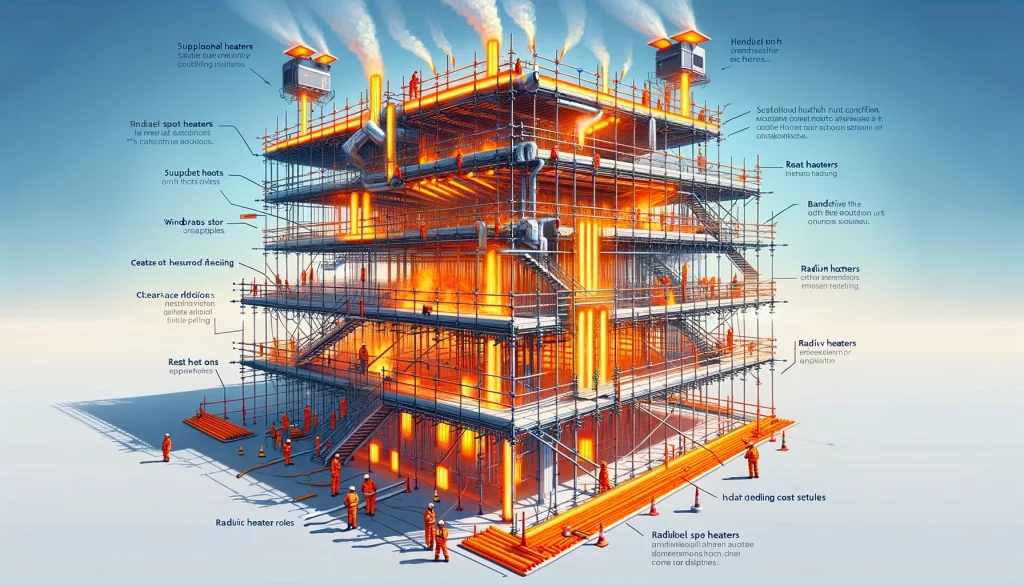
With some testing and adjustment, uniform heating is possible even on expansive scaffolds.
Long-Term Benefits of Efficient Heating on Construction Sites
The advantages of adequate construction site heating extend well beyond the completion of each individual project:
Improved safety culture – Consistently controlling risks proactively
Worker skills development – Proficiency in managing heating equipment safely
Cost predictability – Data to model heating costs accurately
Material knowledge – Insight on curing effects under various heating
Competitive edge – Expertise in a vital but complex area many avoid
Efficient operations – Established procedures for rapid heating deployment
Morale boost – Providing workers comfort and care beyond basic safety
Client satisfaction – Quality and timeliness exceed expectations
Environmental improvement – Refining sustainable heating methods
Innovation – Finding new solutions to gain maximum advantage from heating
Committing to first-class heating practices pays dividends now and well into the future.
Heating Solutions for Different Types of Scaffolding
The optimal heating methods vary by scaffolding type based on structure, exposure, mobility needs, and work performed:
- Suspended – Compact radiant heaters secured to platform underside
- System – Flexible forced air or hydronic looping through frames
- Mobile – Self-powered fuel heaters traveling alongside
- Enclosed – Calefaction or blower systems for full interior warmth
- Shoring – Elongated electric heaters arrayed within each bay
Evaluate:
- Overhead clearance for ducting
- Power source proximity
- Ability to weatherproof enclosures
- The load capacity of the scaffold
- Exposure to wind/rain/snow
- Work being conducted – drying needs
There is no one right heating solution. Carefully match the system design to the scaffolding type for maximum effectiveness.
Winter Construction: Special Considerations for Heaters
Cold-weather construction requires additional precautions regarding heating:
- Monitor the scaffolding framework closely for accumulated ice or snow load
- Frequently remove snow accumulation to prevent collapse
- Use trace heating to keep rain and snowmelt from refreezing on platforms
- Select fuel and power supply storage resistant to freezing
- Position heaters for maximum protection from cold and moisture
- Maintain clear access to heaters for refueling and adjustment
- Use windbreaks and enclosures to contain heat
- Consider supplemental ground thawing equipment like hydronic heating mats
- Plan shortened shifts and rotation for workers to take breaks out of the cold
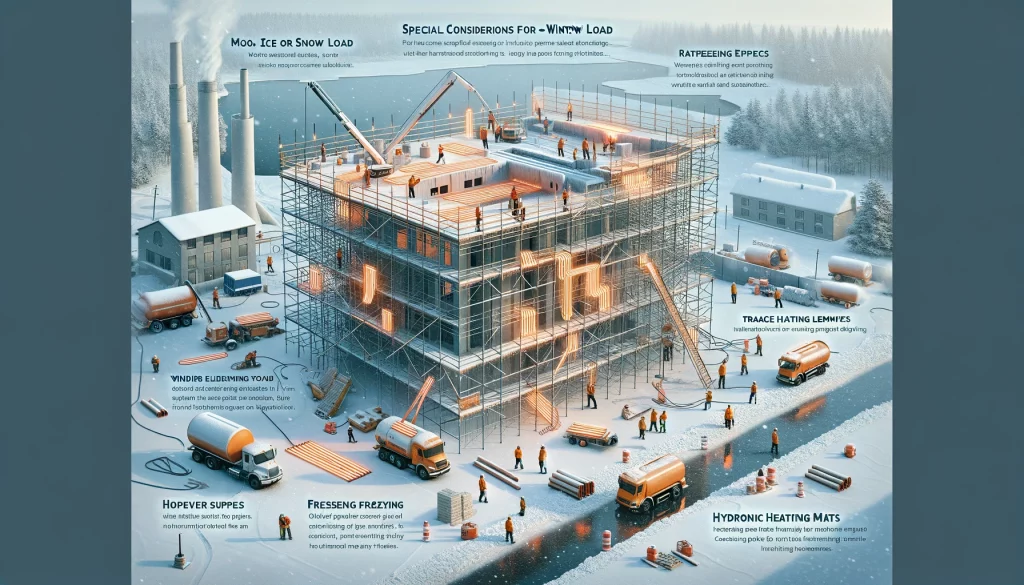
With vigilance and proper preparation, construction can continue safely even in frigid winter weather.
Monitoring and Controlling Heat on Construction Sites
To balance productivity, safety, and efficiency, heat levels on construction sites require active monitoring and control:
- Deploy thermostats and thermometers at key work zones
- Install high temperature sensors near heat sources or heat-sensitive materials
- Position anemometers to monitor air movement around scaffolds
- Use multimeters to check heating electrical loads and detect faults
- Collect data centrally with a heating management control system
- Program setback temperatures for unoccupied times
- Adjust radio thermostats on portable heaters to match changing conditions
- Keep spare heating capacity available for extreme cold periods
- Periodically validate readings through manual checks
Actively managing heat ensures levels remain optimal throughout changing outdoor conditions and shifts. Workers stay safer and more productive without waste.
Custom Heating Solutions for Unique Construction Projects
Standard heating equipment may not suit specialized construction projects. Unique options include:
- Shrink-wrap or custom tarps over irregular scaffolds, with ducted heat inside
- Flexible radiant heating pads adhered to poured concrete forms before fill
- Infrared heating arrays tuned to precisely cure coatings or sealants
- Hydronic tubing cast inside thick concrete pours to accelerate the curing
- Heat exchanger ventilation to conserve heat between exhaust air and fresh air
- Molten salts or heat transfer fluids hold heat for gradual release
- Waste heat capture from generators or equipment to provide auxiliary warmth
Think creatively to develop custom heating approaches that overcome the challenges of non-standard construction.
Reducing Fire Hazards with Proper Heater Usage
Heaters are obviously a major fire hazard if used irresponsibly. Exercise these precautions:
- Prohibit fueling operations on or near scaffolds
- Provide ABC dry chemical extinguishers at every level
- Shut down heaters for torch cutting or welding on scaffolding
- Keep the area below heating units free of combustibles
- Secure electrical cords properly – no frayed wires or overloaded circuits
- Never leave heaters running unattended for long periods
- Install high-temperature limit switches that cut power if overheating
- Use spark arrestors and flashback preventers on fuel heaters
- Maintain clearance distances to combustibles per codes
- Position and orient heaters to direct radiant warmth away from scaffolding
- Routine inspection for damage, leaks, loose connections
With planning, training, and vigilance, the fire risks of temporary heating can be effectively minimized.
Heaters and Scaffolding: Ensuring Structural Integrity
Supporting heavy heating units requires careful structural considerations for scaffolding:
- Use scaffold-grade base plates, mudsills, and sole boards to evenly distribute loads
- Follow manufacturer guidance for allowable unit weights
- Reinforce scaffolding ledgers and transoms supporting heaters
- Install diagonal bracing near heating equipment mounts
- Analyze load paths ensuring no overstressing occurs
- Use load countersunk tie-backs secured to structural walls if needed
- Protect scaffold stability from side forces, vibration, or eccentric loading
- Limit heater mounting height to maintain optimal scaffold stiffness
- Conduct a thorough engineering review of structural heating plans
- Load test finished scaffolding frames before operation
- Monitor for settling or movement during heating operations
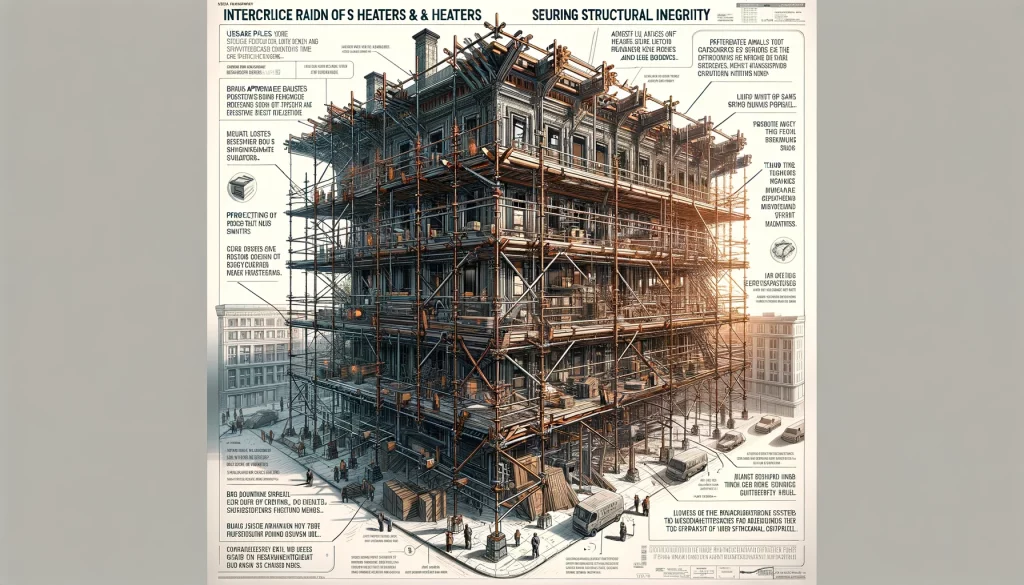
With prudent planning, scaffolding can safely provide both worker access and heating system support.
Case Study: Overcoming Heating Challenges in Cold Climates
Let’s examine how one project team overcame difficult weather obstacles with creative heating approaches:
The Project
A new airport terminal is under construction through a harsh Dakota winter. Work could not stop because of cold conditions.
The Challenges
Frigid temperatures down to -20°F. High winds. Massive scaffolding structures. Concerns about finish curing. Fire hazards.
The Solutions
- Floating flameless catalytic propane heaters distributed throughout each scaffold section
- Custom plexiglass and tarp enclosures built around scaffolds to contain heat
- Hydronic heating pads installed on poured concrete to accelerate curing
- Infrared heating focused on applying spray fireproofing to steel
- Wind turbines generating power for electric heating units
The Outcome
The terminal was built on schedule through the winter thanks to persistent innovation in scaffold heating methods. Despite subzero temperatures, materials were cured properly, and finishes were flawless. Workers stayed warm and productive.
Future Trends in Construction Site Heating
We can expect continued evolution in construction site heating:
- Microwaves and electromagnetic heating – Targeted, rapid, select material heating
- Mobile platforms – Self-contained heating and power generation equipment
- Phase change materials – Store heat for extended release; reusable
- Photovoltaic and solar heating – More renewable on-site power generation
- Wireless optimization – Automated, remote control of multiple heating units
- IoT integration – Sensors, predictive analytics, and operational diagnostics
- Advanced weather protection – New barrier materials, air curtains, heated surfaces
- Modular scaffolding – Prefab frames with integrated heat and power
- Directed radiant energy – Lasers, infrared, and microwaves precisely cure adhesives
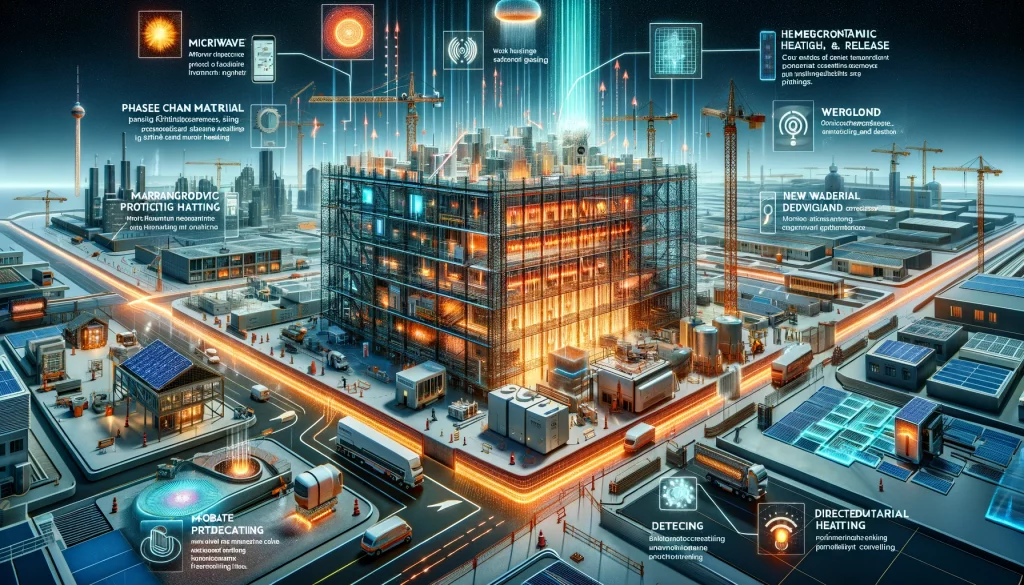
The future holds exciting potential to make temporary heating an even more customizable and efficient tool for construction sites.
Energy-Saving Tips for Construction Site Heaters
Along with maximizing heating effectiveness, it is also important to exercise energy efficiency:
- Monitor work hour needs and setback temperatures during unoccupied times
- Set thermostats only high enough for safe conditions and proper curing
- Select heaters sized appropriately for each space – avoid overcapacity
- Perform regular heater maintenance for optimum performance
- Use tight-focusing radiant heaters directed only where needed
- Add window weatherization and enclosures to contain heat
- Insulate hot water or forced air distribution lines
- Use remote monitoring to identify areas needing better air sealing
- Zone heating to warm only active work areas
- Position duct inlets/outlets for the most efficient airflow patterns
Careful planning and monitoring ensure no energy is wasted heating vacant spaces or overheating materials.
Feedback from Workers: Heater Impact on Productivity
The litmus test for any construction process improvement is direct worker feedback. Regarding site heating, responses are resoundingly positive:
- “It makes the day go by faster when you’re not freezing!” – Mason
- “Keeping the materials warm helps us do higher quality finishing.” – Drywaller
- “The heaters help keep my hands nimble and grip strong.” – Roofer
- “It’s much safer working on the scaffolding when conditions are dry and clear.” – Painter
- “You can really feel the difference in morale when the heaters get set up.” – Framer
- “Proper heat cured the concrete perfectly despite the cold weather.” – Laborer
The productivity and safety dividends from adequate construction site heating are clear to crews. Listen to their needs when designing heating plans.
Heaters and Construction Site Insurance Considerations
Insurers look closely at risk management when evaluating policies for construction companies. Smart heating practices support favorable terms:
- Following expert guidance for equipment selection and safe operation
- Extensive training for all personnel interacting with heating systems
- Meticulous conformance with all codes and permit requirements
- Careful assessment and emergency planning for higher hazard conditions like fuel storage or winter weather
- Detailed inspection and maintenance logs showing diligent equipment upkeep
- Objective incident investigation and corrective actions for heating mishaps
- Seeking continuous improvements through monitoring key metrics
Premium discounts may apply for demonstrable commitment to safety and risk control in heating. Avoiding even one loss event covers years of savings.
Make heating safety core to your organization’s culture. The benefits extend far beyond any individual project.
Troubleshooting Common Issues with Construction Heaters
Being prepared to address heater problems helps avoid major disruptions:
No or low heat output
- Check fuel/power supply
- Clean air intakes and filters
- Test fan blower operation
- Assess for exchanger leaks or blockages
- Confirm ducting is intact; locate obstructions
Noise or vibration
- Tighten mountings
- Rebalance or align fan impellers
- Inspect motor mountings
- Adjust baffles/ducting causing turbulence
Burning smells or smoke
- Shut down the heater and clean the exchanger/ducts
- Check for wiring short circuits
- Clean or replace air filters
Power fluctuations
- Ensure adequate generator capacity
- Reset circuit breakers
- Test for faulty cords or loose connections
- Keep loads balanced across electrical phases
Summary: Key Takeaways on Heaters in Scaffolding Projects
In summary, the principal points on safely maximizing efficiency with construction site heating:
- Heating benefits safety, quality, productivity, schedules
- Match heater types to needs – radiant, forced air, hydronic
- Prioritize worker comfort and material curing temperatures
- Follow codes and permit procedures closely
- Strategically place and zone heaters only where needed
- Insulate distribution runs to avoid waste
- Monitor conditions actively and make adjustments
- Service heaters routinely per manufacturer guidelines
- Train everyone on safe operation and emergency response
- Cleanup fuel spills immediately and safely
- Load test scaffolding to confirm ample structural capacity
- Learn from experience to optimize future heating operations
Construction site heating may seem daunting initially but pays major dividends. With diligent planning and implementation, crews can conquer weather and stay on track.
Conclusion: The Future of Safety and Efficiency in Construction
Heating technology will continue evolving quickly, providing new options to maintain safe, productive conditions on construction sites.
But advanced equipment alone is not the full answer. Lasting gains require instilling a culture of safety and efficiency at all levels:
- Management commitment to worker wellbeing and performance
- Engineering rigor in equipment selection and scaffold integration
- Meticulous planning considering all hazards and challenges
- Comprehensive training so everyone has needed skills
- Active monitoring and control of heating effects
- Diligent maintenance for peak equipment functionality
- Incident transparency without blame to drive improvement
- Industry collaboration to elevate best practices
Adopting modern heating equipment is just the first step toward excellent cold weather performance. Set the tone from the top that safety and productivity are inseparable goals. Empower teams to innovate heating techniques. Learn continuously.
With focus and persistence, construction leaders can build their reputations performing the “impossible” – delivering under budget and ahead of schedule even through the harshest winter conditions. Be the company that weathers any storm.


